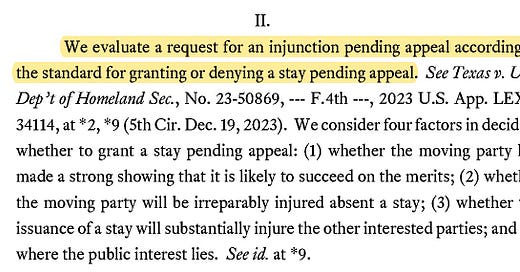Bonus 61: Injunctions Pending Appeal
The distinction between a stay and an injunction "pending appeal" may seem arcane, but its blurring has resulted in a significant transfer of power from federal district judges to appellate courts
Welcome back to the weekly bonus content for “One First.” Although Monday’s regular newsletter will remain free for as long as I’m able to do this, much of the bonus content is behind a paywall to help incentivize those who are willing and able to support the work that goes into putting this newsletter together every week. I’m grateful to those of you who are already paid subscribers, and hope that those of you who aren’t will consider a paid subscription if your circumstances permit:
This week’s bonus content is inspired by two unrelated developments from last week. The first came on Friday afternoon, when the Court (as I noted on Monday) granted two applications to stay a district court injunction in the dispute between the federal government and Idaho over whether EMTALA preempts Idaho’s abortion ban insofar as it requires doctors to perform medically necessary abortions in contexts that are not life-saving (i.e., to stabilize an emergency, but not life-threatening, medical condition). The Court’s order offered no explanation, which is especially exasperating because, whatever one thinks of the merits, it’s really hard to see the argument that the injunction was causing the kind of “irreparable harm” to Idaho that at least used to be a prerequisite for emergency relief.1
The second came in a Fifth Circuit ruling on Thursday, in which the court of appeals refused to grant emergency relief in a dispute over whether the State of Mississippi violated the federal Constitution when it created a new court system for Jackson (largely to take control of the local courts in the state capital away from the more left-leaning jurisdiction—something that Texas just did, as well). In explaining the denial of relief, the unsigned Fifth Circuit ruling opened by stating that “[w]e evaluate a request for an injunction pending appeal according to the standard for granting or denying a stay pending appeal.” No, really:
This statement is categorically incorrect as a statement of law. (The decision it cites for the proposition does apply the stay standard to an inunction pending appeal, but with no supporting analysis of its own, so it’s the original sin.) For present purposes, though, it’s quite revealing of two related points: In recent years, a number of appellate courts (including the Supreme Court) have conflated the very different purposes of and standards for a stay pending appeal and an injunction pending appeal. And the result has been a massive aggrandizement, by these appellate courts, of the traditional authority (and equitable discretion) of district courts. Simply put, this doctrinally and analytically indefensible move has empowered appellate courts to effectively act as trial courts when it comes to preliminary injunctive relief—and the Supreme Court ought to clean up this mess rather than continue to hand down unexplained rulings (like last Friday’s) that reflect (and thereby enable) comparable carelessness.
For those who are not paid subscribers, the next free installment of the newsletter will drop on Monday morning. For those who are, please read on.
Keep reading with a 7-day free trial
Subscribe to One First to keep reading this post and get 7 days of free access to the full post archives.




